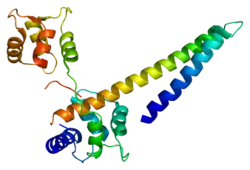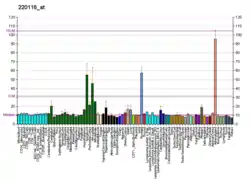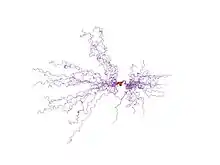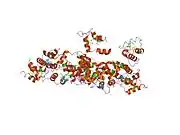KCNN2
Potassium intermediate/small conductance calcium-activated channel, subfamily N, member 2, also known as KCNN2, is a protein which in humans is encoded by the KCNN2 gene.[3] KCNN2 is an ion channel protein also known as KCa2.2.[4]
Function
Action potentials in vertebrate neurons are followed by an afterhyperpolarization (AHP) that may persist for several seconds and may have profound consequences for the firing pattern of the neuron. Each component of the AHP is kinetically distinct and is mediated by different calcium-activated potassium channels. The KCa2.2 protein is activated before membrane hyperpolarization and is thought to regulate neuronal excitability by contributing to the slow component of synaptic AHP. KCa2.2 is an integral membrane protein that forms a voltage-independent calcium-activated channel with three other calmodulin-binding subunits. This protein is a member of the calcium-activated potassium channel family. Two transcript variants encoding different isoforms have been found for the KCNN2 gene.[4]
In a 2009 study, SK2 (KCNN2) potassium channel was overexpressed in the basolateral amygdala using a herpes simplex viral system. This reduced anxiety and stress-induced corticosterone secretion at a systemic level. SK2 overexpression also reduced dendritic arborization of the amygdala neurons.[5] In a 2015 study, it was found that UBE3A, the protein maternally deleted in Angelman syndrome, marks KCNN2 for degradation in the hippocampus, and that UBE3A deficiency is associated with an increase in KCNN2 levels. KCNN2 operates through a negative feedback loop to reduce glutamatergic NMDA receptor activation when it itself is activated by that same receptor. Angelman syndrome therefore leads to a reduction in glutamatergic NMDA receptor activation, which impairs long-term potentiation of hippocampal neurons and thus fear conditioning.[6]
References
- GRCh38: Ensembl release 89: ENSG00000080709 - Ensembl, May 2017
- "Human PubMed Reference:". National Center for Biotechnology Information, U.S. National Library of Medicine.
- Wei AD, Gutman GA, Aldrich R, Chandy KG, Grissmer S, Wulff H (December 2005). "International Union of Pharmacology. LII. Nomenclature and molecular relationships of calcium-activated potassium channels". Pharmacol. Rev. 57 (4): 463–72. doi:10.1124/pr.57.4.9. PMID 16382103. S2CID 8290401.
- "Entrez Gene: KCNN2 potassium intermediate/small conductance calcium-activated channel, subfamily N, member 2".
- Mitra R, Ferguson D, Sapolsky RM (February 2009). "SK2 potassium channel over-expression in basolateral amygdala reduces anxiety, stress-induced corticosterone and dendritic arborization". Mol. Psychiatry. 14 (9): 847–55, 827. doi:10.1038/mp.2009.9. PMC 2763614. PMID 19204724.
- Sun, Jiandong; Zhu, Guoqi; Liu, Yan; Standley, Steve; Ji, Angela; Tunuguntla, Rashmi; Wang, Yubin; Claus, Chad; Luo, Yun; Baudry, Michel; Bi, Xiaoning (2015-07-21). "UBE3A Regulates Synaptic Plasticity and Learning and Memory by Controlling SK2 Channel Endocytosis". Cell Reports. 12 (3): 449–461. doi:10.1016/j.celrep.2015.06.023. ISSN 2211-1247. PMC 4520703. PMID 26166566.
Further reading
- Wei AD, Gutman GA, Aldrich R, et al. (2006). "International Union of Pharmacology. LII. Nomenclature and molecular relationships of calcium-activated potassium channels". Pharmacol. Rev. 57 (4): 463–72. doi:10.1124/pr.57.4.9. PMID 16382103. S2CID 8290401.
- Jäger H, Adelman JP, Grissmer S (2000). "SK2 encodes the apamin-sensitive Ca2+-activated K+ channels in the human leukemic T cell line, Jurkat". FEBS Lett. 469 (2–3): 196–202. doi:10.1016/S0014-5793(00)01236-9. PMID 10713270. S2CID 44455392.
- Liu QH, Williams DA, McManus C, et al. (2000). "HIV-1 gp120 and chemokines activate ion channels in primary macrophages through CCR5 and CXCR4 stimulation". Proc. Natl. Acad. Sci. U.S.A. 97 (9): 4832–7. doi:10.1073/pnas.090521697. PMC 18318. PMID 10758170.
- Desai R, Peretz A, Idelson H, et al. (2001). "Ca2+-activated K+ channels in human leukemic Jurkat T cells. Molecular cloning, biochemical and functional characterization". J. Biol. Chem. 275 (51): 39954–63. doi:10.1074/jbc.M001562200. PMID 10991935.
- Rimini R, Rimland JM, Terstappen GC (2001). "Quantitative expression analysis of the small conductance calcium-activated potassium channels, SK1, SK2 and SK3, in human brain". Brain Res. Mol. Brain Res. 85 (1–2): 218–20. doi:10.1016/S0169-328X(00)00255-2. PMID 11146124.
- Schumacher MA, Rivard AF, Bächinger HP, Adelman JP (2001). "Structure of the gating domain of a Ca2+-activated K+ channel complexed with Ca2+/calmodulin". Nature. 410 (6832): 1120–4. doi:10.1038/35074145. PMID 11323678. S2CID 205016620.
- Miller MJ, Rauer H, Tomita H, et al. (2001). "Nuclear localization and dominant-negative suppression by a mutant SKCa3 N-terminal channel fragment identified in a patient with schizophrenia". J. Biol. Chem. 276 (30): 27753–6. doi:10.1074/jbc.C100221200. PMID 11395478.
- Strausberg RL, Feingold EA, Grouse LH, et al. (2003). "Generation and initial analysis of more than 15,000 full-length human and mouse cDNA sequences". Proc. Natl. Acad. Sci. U.S.A. 99 (26): 16899–903. doi:10.1073/pnas.242603899. PMC 139241. PMID 12477932.
- Piotrowska AP, Solari V, Puri P (2003). "Distribution of Ca2+-activated K channels, SK2 and SK3, in the normal and Hirschsprung's disease bowel". J. Pediatr. Surg. 38 (6): 978–83. doi:10.1016/S0022-3468(03)00138-6. PMID 12778407.
- Xu Y, Tuteja D, Zhang Z, et al. (2004). "Molecular identification and functional roles of a Ca2+-activated K+ channel in human and mouse hearts". J. Biol. Chem. 278 (49): 49085–94. doi:10.1074/jbc.M307508200. PMID 13679367.
- Ota T, Suzuki Y, Nishikawa T, et al. (2004). "Complete sequencing and characterization of 21,243 full-length human cDNAs". Nat. Genet. 36 (1): 40–5. doi:10.1038/ng1285. PMID 14702039.
- Feranchak AP, Doctor RB, Troetsch M, et al. (2004). "Calcium-dependent regulation of secretion in biliary epithelial cells: the role of apamin-sensitive SK channels". Gastroenterology. 127 (3): 903–13. doi:10.1053/j.gastro.2004.06.047. PMID 15362045.
- Tajima N, Schönherr K, Niedling S, et al. (2006). "Ca2+-activated K+ channels in human melanoma cells are up-regulated by hypoxia involving hypoxia-inducible factor-1α and the von Hippel-Lindau protein". J. Physiol. 571 (Pt 2): 349–59. doi:10.1113/jphysiol.2005.096818. PMC 1796787. PMID 16396931.
- Lu L, Zhang Q, Timofeyev V, et al. (2007). "Molecular coupling of a Ca2+-activated K+ channel to L-type Ca2+ channels via alpha-actinin2". Circ. Res. 100 (1): 112–20. doi:10.1161/01.RES.0000253095.44186.72. PMID 17110593.
- Morimoto T, Ohya S, Hayashi H, et al. (2007). "Cell-cycle-dependent regulation of Ca2+-activated K+ channel in Jurkat T-lymphocyte". J. Pharmacol. Sci. 104 (1): 94–8. doi:10.1254/jphs.SC0070032. PMID 17452806.
- Dolga AM, Terpolilli N, Kepura F, et al. (2011). "KCa2 channels activation prevents [Ca2+]i deregulation and reduces neuronal death following glutamate toxicity and cerebral ischemia". Cell Death Dis. 2 (e147): e147. doi:10.1038/cddis.2011.30. PMC 3122061. PMID 21509037.
This article incorporates text from the United States National Library of Medicine, which is in the public domain.







